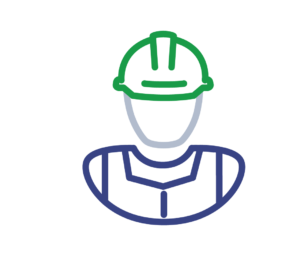
Replacing “Stick Built” with “Systems Built”
Custom home builders for years have used the term “stick built” to label their homes as higher quality. The logic is that if you build a home one stick at a time, then you have taken the time to cut, place, and fasten each “stick” correctly. This is a distraction from what it really is. “Stick built” is actually the term for onsite construction. Do you really think you can cut, place, and fasten each stick correctly building outdoors in the heat, cold, rain, and wind and without automated tools? And all of this being done on uneven ground where the tools needed have to be brought to the job-site every day.
A “systems built” home describes a home built using some form of systemized construction process
A building system automates the processes of cutting, placing, and fastening each “stick”. All of this is done offsite and indoors allowing homes constructed using a building system to achieve precision and efficiency beyond what is possible when “stick building” onsite.
Types of Building systems
The National Association of Home Builders recognizes four types of construction using building systems:
Concrete Panel & Form Construction
Concrete panel and form construction is becoming a more popular options for residential home construction
Log & Timber Home Construction
Log home owners are like Harley owners, they are looking for a specific look and feel from their new home.
Structured Insulated Panels (SIPS)
Panelized homes are considered a high performance building system that is an inherently green product.
Modular Home Construction
Modular construction is a home building system where 75-85% of the home is delivered complete.

Concrete & Panel Form Construction
Most think of concrete construction for commercial buildings. However, there has been a growing interest and use of concrete for residential construction.
There are several methods to utilize concrete. A popular one for residential construction is panel systems. The panels are typically precast and then placed with a crane. These are precast panels that are cast/made offsite at a manufacturing facility and then trucked to the site for installation. Removable forms are what most think of for foundations. However, when casting above grade, foam insulation is typically placed in the forms before pouring begins. This results in a solid wall with high thermal mass. This method still requires that all trades still participate fully in the onsite completion process.
Log and Timber Home Building
Log and timber home building have been around for hundreds of years. The process of harvesting and drying the logs and timber has improved over the years.
Methods to seal areas between logs and at mating areas of roofs and walls have improved. However, log home owners are like Harley owners, they are looking for a specific feeling from the product and not everyone is looking for that.
Log and timber homes are a part of the building systems industry and will continue to thrive as a niche building system. Modular construction offers the ability to mimic the log home look and feel with higher energy efficiency and at a lower cost to the home buyer.


Panelized Home Building
Within panelized home building there are several subcategories. Two of the main ones being basic panelized construction and another one known as Structural Insulated Panels (SIPS).
Using basic panels, a home plan is divided into wall and roof sections and are framed off site in a factory. The panels are then loaded flat on large trucks and delivered to the site. Each panel is coded and the entire home is assembled, much like a puzzle with the coded pieces.
However, the panels typically do not contain plumbing, electrical wiring, and finished interiors or exteriors. This requires all of the onsite completion by trades as is typical with traditional onsite construction. SIPS are considered a high performance building system that consists of an insulating foam core that is sandwiched between two structural facings. SIPS are considered one of the most airtight and well insulated building systems making them an inherently green product.
Modular Home Building
Modular construction consists of many modular subassemblies built and assembled in an environmentally controlled factory that are assembled into a larger component, or module. That module is then shipped to a building site, combined with other modules, and assembled into a finished product.
Most homes built using modular construction are delivered to the site 75-85% complete. The impacts of weather as a factor in home construction is virtually eliminated. By keeping rain and moisture out of the home during construction, a healthy living environment is promoted by keeping floors and walls dry during construction, unlike with traditional site built homes. This reduces the risk of mold and mildew growth.

Case Studies
Here are some examples of homes we have provided that used the hybrid approach to cost-effectively provide a unique design and that allowed most of the home to be completed at the factory, reducing onsite time to completion.
Home on the Bay Set on Pilings
Hybrid construction, combining modular with panelized construction can be very cost effective when building high. Building high in some cases can double the cost of conventional construction because of the extra efforts required to move men and material to the higher work area. Because both modular and panelized construction methods require a crane, those costs are already built in. The home modules were set (installed on the pier foundation) in the early morning. The panelized roof and second floor were completed by mid-afternoon, and roof shingling was complete before the sunset that evening.
In one day this complex home was constructed (assembled) onsite and roof shingling was complete. The kitchen, fireplace, bathroom, flooring, drywall, trim, etc. were fully complete in the modular sections of the home. Onsite the panelized sections required completion. The advantage is that the first floor modules were prepared with electrical and plumbing connections to facilitate the quick completion of the panelized second floor of this home
Unique Home With Hybrid SIPs Construction
A home doesn’t have to be large to be complex. Engineering unique roof designs for construction can require creativity to meet the home design requirements and also meet the structural engineering requirements. Panels provide the perfect complement to modular construction to meet unique design requirements cost effectively.
In this home the first floor contained a garage, kitchen, and living room with an open to above area in the living room. Using panels allowed for a 3’ knee wall on the second floor exterior wall while the LVL beam and panelized roof structure provided the ability to engineer the customers required roof design for their home. The first floor even came equipped with all of the pex tubing installed for radiant floor heating. This home was assembled and under roof in one day, ready for the metal roof to be installed the next day.
Engage Impresa Modular Pro early in the decision making process to take full advantage of modular construction

1. PRE-CONSTRUCTION
We know what it takes to convert solely to modular construction or to integrate modular construction where it will benefit you most.

2. DESIGN
Our MODULARIZE® design methodology produces a project that is hyper-optimized for offsite construction from start to finish.

3. BUILD
Our off-site construction approach involves the utilization of multiple building systems with the dominant system being modular construction.







